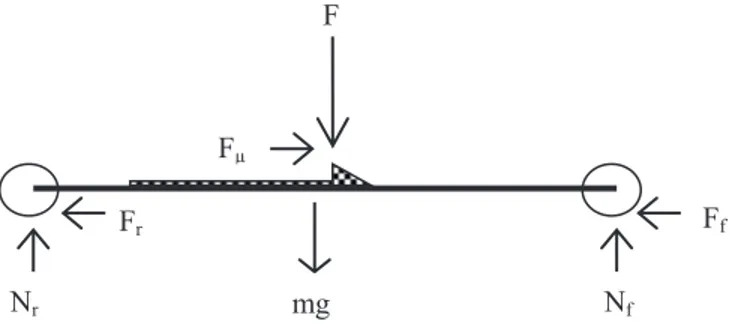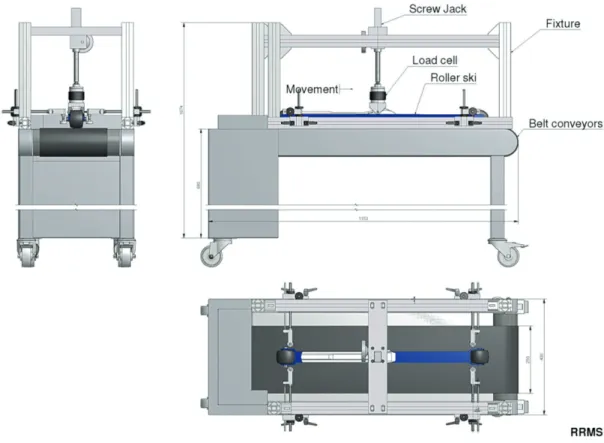Procedia Engineering 60 ( 2013 ) 79 – 83
1877-7058 © 2013 The Authors. Published by Elsevier Ltd.
Selection and peer-review under responsibility of the School of Aerospace, Mechanical and Manufacturing Engineering, RMIT University doi: 10.1016/j.proeng.2013.07.078
6
thAsia-Pacific Congress on Sports Technology (APCST)
A portable roller ski rolling resistance measurement system
Mats Ainegren
a*, Peter Carlsson
a, Mats Tinnsten
aaDepartment of Engineering & Sustainable Development, Mid Sweden University, Östersund 831 25, Östersund
Received 20 March 2013; revised 6 May 2013; accepted 2 June 2013
Abstract
Roller skis are used by cross-country skiers, biathletes and ski-orienteers for their snow-free training and in roller ski competitions. Additionally, much of the current sports research into the physiology and biomechanics of cross-country skiing is conducted indoors on treadmills using roller skis. For elite athletes, the differences in performance are quite small, thus emphasising the importance of knowing the roller s , especially in connection to research and roller ski competitions. The purpose of this study was to develop a roller ski rolling resistance measurement system (P-RRMS) that is portable and therefore useful in different contexts and locations. The P-RRMS was designed as a small treadmill, equipped with roller ski stabilizing lateral supports and a screwed bar for applying different vertical loads on the roller ski. The design uses only one force sensor, with possible measurements of three directions of force and torque around three axes. The weight of the P-RRMS is 100 kg and it is equipped with wheels to facilitate transportation.
© 2013 Published by Elsevier Ltd. Selection and peer-review under responsibility of RMIT University
Keywords:Portable device; roller skis, rolling resistance, 3D sensor
1. Introduction
Roller skis are used by cross-country skiers, biathletes and ski-orienteers for their snow-free training and in roller ski competitions. Additionally, much of the current sports research into the physiology and biomechanics of cross-country skiing is conducted indoors on treadmills using roller skis.
Freestyle and classical style roller skis of the same model coming from the same manufacturer have been shown to have variations in the rolling resistance coefficient (μR) of about 30% [1]. Further, subsequent physiological tests showed that submaximal oxygen uptake, heart rate, blood lactate and time to exhaustion, from incremental maximal tests, were highly influenced by changes in μR [2].
* Corresponding author. Tel.: +46-63-165372; fax: +46-63-165740.
E-mail address: Mats.Ainegren@miun.se. © 2013 The Authors. Published by Elsevier Ltd.
Selection and peer-review under responsibility of the School of Aerospace, Mechanical and Manufacturing Engineering, RMIT University
distributing the body mass evenly on both roller skis [3]. Another method used specially designed equipment for roller ski rolling resistance measurements with heavy lead plates to simulate different body masses [1]. In both cases the experiments were carried out on large treadmills.
Thus, the purpose of this study was to develop a portable roller ski rolling resistance measurement system (P-RRMS), independent of a skier and heavy lead plates.
2. Methods
The P-RRMS was designed as a small motorized treadmill (Rodby Innovation, Vänge, Sweden), equipped with wheels to facilitate transportation. The basic design was equipped with beams, roller ski stabilizing lateral supports consisting of ball bearing wheels and a screwed bar for applying different loads (F) normal to the surface, in the ski binding at the ski boot fix point (Side System AB, Oviken, Sweden). The bar was equipped with a force transducer (NET Force/Torque sensor Mini58, ATI Industrial Automation, Apex, USA), measuring forces and torques in 3 directions around three axes (FX, FY, FZ, TX, TY, TZ).
Nomenclature
F vertical load on roller ski [N] m mass of the roller ski [kg]
g acceleration due to gravity [m . s-2] μR coefficient of rolling resistance
Ff resisting force of the forward wheel [N] Fr resisting force of the rear wheel [N] Fμ total resisting force [N]
Nf normal force on the forward wheel [N] Nr normal force on the rear wheel [N] Ntotal total normal force [N]
2.1. Mechanics of the roller ski
Fig. 1. The figure shows a free body diagram of a roller ski and inff teracting forces.
Horizontal equilibrium shows that: 0 r f Fr Ff F F (1)
Vertical equilibrium shows that:
0 r f Nr Nf mg F (2(( )2
With the coefficient of rolling resistance (μR) defined as the ratio of the total resisting force (Ff+ Fr) to the total normal force (Ntotal), the following relationship can be established:
mg F F N N F F N r N N f N r F F f F F total N N R F ) ( (3)
This relationship can be used in calculations of μRin experiments carried out with the P-RRMS. The individual normal forces (Nfand Nr) can be calculated if Fig. 1 is supplemented with the position of the roller ski centre of mass, the horizontal distances between the wheels and F and the vertical distance between the treadmill rubber mat and the ski boot fix point, i.e. where F is applied on the roller skia .
2.2. Experiments
A reproducibility study was carried out in order to investigate the methodological error for this new type of equipment. Measurements were carried out with one classical and one free style roller ski (PRO-SKI C2, Sterners, Sweden; Marwe freestyle, Hyvinkään Kumi OY, Finland) at a rate of 1 Hz. Nine different vertical loads F within a 100 N interval (200-1000 N) were put on the roller ski. The speed was 15 km/h, the duration of each measurement was five minutes and a mean μRwas calculated for the last 60 s. The procedure was repeated the following day. The methodological error was calculated using Technical Error of Measurement (TEM):
(4 (( )4 (5 (( )5
where di is the difference between the paired measurements (M1 and M2) and n is the number of paired measurements. Finally, paired Student t test was used to investigate any statistical difference between the paired measurements. The level of significance was set at p < 0.05. Further experiments with the P-RRMS will be presented in future publications.
F mg Nf Nr Ff Fr Fμ
30 km/h and the size of the rubber mat upper surface is 0.9 × 0.25 m. The vertical force F is applied in one single point, in the ski binding at the ski boot fix point, and the maximum t measureable F as the sensor can measure is 6800 N .
Fig. 2. The portable rolling resistance measurement system (P-RRMS). Movement indicates the possibility of moving the sensor in the roller ski travel direction. Belt corresponds to rubber mat.
The results of the reproducibility study showed no significant difference between the paired measurements with either the classical (t = -1.571, p = 0.155) or the free style (t = 0.347, p = 0.737) roller ski and the TEM was relatively small (0.0013 μRand 5.1 %, 0.0009 μRand 3.2 %, respectively).
4. Discussion
The P-RRMS is equipped with wheels to facilitate transportation and it has an appropriate working height from an ergonomic point of view and does not imply heavy lifting with weights as was the case with an earlier prototype [1].
The size of the rubber mat upper surface should be sufficient to cover all types of roller skis on the market of different classical and free style design.
The roller ski stabilizing lateral supports are easy adjustable in three directions and the small ball bearing wheels enable the normal control against appropriate surfaces of various types of roller skis and minimizes the influence of forces in the roller ski travel direction.
Since the system uses only one force sensor, which attaches to a single point at the middle of the roller ski, a simple and superior method is obtained for measurement of forces in various directions. In addition, the bracket fits in both the ski binding systems available on the market (Rottefella, Salomon).
The use of the P-RRMS makes it possible to prepare roller skis for upcoming physiological experiments on any treadmill with similar type of rubber mat. When using roller skis in other contexts and surfaces, such as during roller ski competitions which normally takes place on asphalt, the rolling resistance coefficient may not be exactly the same as measured on the rubber mat. However, it is likely that different roller skis, but equipped with wheels of same material and with similar rolling resistance coefficient (detected with the P-RRMS), will also remain similar interrelation on other surfaces. Moreover, if roller skis also come equipped with an adjustable rolling resistance function [4], there will not be any need for a large inventory of different roller skis to find couples with similar coefficients.
5. Conclusion
The chosen design for the portable rolling resistance measurement system makes it ergonomic and easy to operate and can be used to investigate μR for all types of classical and free style roller skis on the market.
Acknowledgements
for this project.
References
[1] Ainegren M, Carlsson P, Tinnsten M. Rolling resistance for treadmill roller skiing. Sports Eng 2008;11:23-29
[2] Ainegren M, Carlsson P, Tinnsten M. Roller ski rolling resistance and its effects on elite athletes' performance. Sports Eng 2009;11:143-157
[3] Hoffman MD, Clifford PS, Bota B, Mandli M, Jones GM. Influence of body-mass on energy-cost of roller skiing. Int J Sport
Biomech 1990;4:374-385
[4] Ainegren M, Rännar L-E, Carlsson P, Tinnsten M. The multifunctional roller ski. In: Hakkarainen A, Lindinger S, Linnamo V (eds). 2nd International Congress on Science and Skiing, Vuokatti; 2012, p. 82

